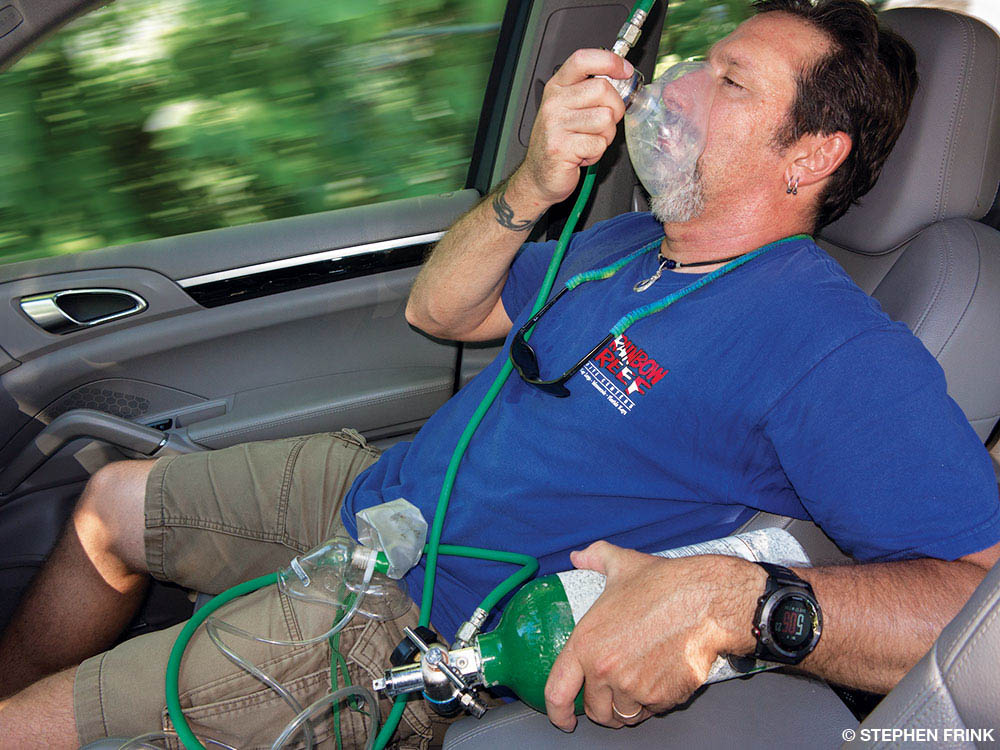Latest from the Incident Insights series by Divers Alert Network
The Diver
The diver was a 45-year-old male dive instructor with approximately 300 lifetime dives. He denied taking any medication and reported no history of medical conditions.
The Dives
The diver was teaching an advanced open-water course at a local lake popular with divers. The water temperature ranged from 78°F to 92°F. He was accompanied by his wife, who was assisting the class as a divemaster, for a series of five dives over the weekend. They completed three dives on Saturday with long surface intervals between the dives followed by a 16.5-hour surface interval before the first dive
on Sunday.
The first dive on Sunday was 34 minutes long with an average depth of 53 feet and, to meet the depth requirement of the course, a maximum depth of 98 feet. After a 90-minute surface interval, the divers began their second dive of the day, which focused on search-and-recovery skills. It was a 48-minute dive with an average depth of 50 feet and a maximum depth was 63 feet. The diver reported nonstressful dives with minimal exertion besides following and monitoring his students. The dives were within recreational limits, and his dive computer was in a conservative setting. His fastest ascent of the weekend was at a rate of 29 feet per minute.
Complications
As everyone was packing up after the fifth and final dive of the weekend, the diver began to experience a dull ache in his right shoulder and numbness in his right leg. When he began to have difficulty walking, he asked his wife to make the drive back to the scuba shop. After a few minutes in the car, the diver’s right arm started feeling cold. He checked to make sure the cold sensation was not because of the damp, long-sleeved rash guard he was wearing or the cold air blowing from the air conditioner. He then noticed that the cold sensation had turned to numbness and slight tingling that progressed down his right arm and leg.
They pulled over the vehicle and set up their DAN® oxygen unit, and the diver began breathing from the demand valve. They also set up the nonrebreather mask in case the diver lost consciousness. Once the diver was breathing 100 percent oxygen, his wife called DAN. The DAN medic assessed the situation and directed them to the nearest emergency room.
Fortunately, the diver’s symptoms subsided after approximately 45 minutes of breathing pure oxygen. When he reached the hospital, there was no more numbness or tingling in his arm, and he could walk normally again. Although his symptoms were gone, he was admitted to the emergency room for further analysis. When the diver arrived, he was put on a nonrebreather mask with a flow rate of 15 liters per minute. The emergency room doctor was in contact with DAN medics, who provided contact information for multiple hyperbaric medical specialists in the area for further consultation.
The diver continued to breathe pure oxygen for about two hours, and his symptoms never returned. He underwent multiple tests, including an electrocardiogram, MRI, CT scan and chest X-rays, all of which were unremarkable. The doctor monitored the diver for three and a half hours before releasing him. In total, the diver breathed 100 percent oxygen for approximately five hours, with the exception of during testing and necessary breaks.
The doctors ultimately determined this may have been a case of decompression sickness (DCS) that resolved before the diver was admitted to the hospital. The diver’s report of mild unilateral upper- and lower-extremity paresthesia that were resolved by surface-supplied oxygen suggests central nervous system DCS. The general recommendation in such cases is to treat with hyperbaric oxygen therapy (HBOT) regardless of symptom resolution. In this case, after extensive testing and prolonged monitoring, the physician was confident HBOT was not necessary.
Discussion
This incident is a good example of how being a prepared diver and having an emergency action plan can prove fortunate. The diver ensured he was properly hydrated, well fed and sufficiently rested throughout his weekend of diving. Although the reported dive profiles were within the diver’s computer limits, with slow ascents and adequate surface interval time between dives, he still recognized and acknowledged the signs and symptoms of neurological DCS. If the diver had ignored the symptoms and waited longer to seek professional medical attention, his eventual recovery might not have been so swift and/or complete.
In many cases, divers choose to neglect DCS symptoms or attribute them to a separate cause such as heavy lifting, a tight wetsuit or overexertion. The diver contemplated the numbness and tingling sensation in his extremities, astutely recognized these symptoms and took immediate action. He acknowledged that there are risks associated with scuba diving and was adequately prepared with an emergency oxygen unit with various types of breathing apparatus. Both the diver and his buddy were trained in how to use the emergency oxygen and how to determine when medical intervention is necessary.
The diver’s doctor advised him to discontinue repetitive deep dives, consult a neurologist for other possible explanations for his symptoms, get screened for a patent foramen ovale (PFO) and wait 30 days before returning to diving. The diver has returned to diving since the incident and has not experienced further problems.
This incident can serve to remind all divers of the importance of self-awareness and having an emergency action plan. It is crucial to be mindful when considering symptoms, to have an immediate oxygen supply available and to seek professional medical attention promptly when necessary.
© Alert Diver — Q4 Fall 2016







